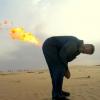|
|
Determining Back Pressure When Sizing For Prv
#1

Posted 28 November 2012 - 07:38 AM
I need some help with regards to calculating the superimposed back pressure and built-up back pressure present at the outlet of a pressure relief valve I’m trying to size for.
There is a positive displacement pump that draws fluid from a tank that is open to the atmosphere. The discharge piping of the pump discharges through a pipe that is also open to the atmosphere. There is a pressure relief valve located on the discharge piping that routes the fluid back to the suction of the pump in the event of overpressure.
I’ve looked at various sources and have been unable to determine the proper steps in finding the back pressure. I would greatly appreciate it if someone can point me in the right direction. I figure that I would have to back calculate from the end of the discharge piping to the pump discharge nozzle for the first step, but I’m unsure on how to proceed, especially on what flow rates to use (i.e. Max pump flow rate, PRV relief rate, or combined).
Thanks.
#2

Posted 28 November 2012 - 08:03 AM
Your query isn't so clear to me; at a glance you might conduct the PSV outlet to the tank itself instead the pump suction with considering pilot operated PSV which can tolerate higher back pressure withour capacity reduction.
Anyway for better assistance please upload a simple sketch of the system along with the additional information.
Fallah
#3

Posted 28 November 2012 - 08:09 AM
#4

Posted 28 November 2012 - 05:30 PM
1. A sketch would be useful, as fallah notes. Discharge PSV line had better go to tank (not to suction line) to avoid heating due to short circulation; yet connection to suction line is also met, probably on the assumption that Operator will correct things soon after PSV opens due to blocked discharge. Alarm may be judged necessary, if connection occurs to suction line.
2. A positive displacement pump has practically one flow rate Q. This Q is reduced at higher discharge pressures due to slippage, but to a small extent; http://www.driedger.ca/ce2_pdp/CE2_PDP.html, Fig 2-2 .
3. Flow through PSV : Q, it cannot be more (I think slippage at set pressure could be taken into account, Q is a bit more conservative). Practice to consider rated PSV flow is judged non applicable here.
4. PSV set pressure: design pressure.
5. Superimposed back pressure: Pressure at the suction line point connected to PSV discharge. Maximum value at full tank (HHLL).
6. Built up back pressure: Frictional pressure drop for flow rate Q in the PSV discharge line.
7. Note: For conventional PSV max total back pressure has to be lower than 10% of set pressure, which defines PSV discharge line diameter.
Hopefully helpful, comments welcomed,
Edited by kkala, 28 November 2012 - 05:34 PM.
#5

Posted 29 November 2012 - 08:08 AM
I understand that routing it back to the tank is a better option, but we have multiple tanks which we switch around and it is not that feasible.
From what kkala said, would superimposed back pressure simply be rho*g*h of the height difference between the PRV and the highest level of fluid level possible within the tank?
As for built-up back pressure, how would you take into account the frictional pressure drop for flow rate in the PSV discharge line? For example, I know that pressure drop per 100 ft is 0.048 psi for water flowing at 1 gal/min through a 1" Schedule 40 pipe. How can I calculate built-up back pressure from this information?
Thanks.
Attached Files
#6

Posted 29 November 2012 - 03:31 PM
Then there is short circuit around the pump at flowrate Q (post No 4), with zero flow downstream of the valve or upstream of the point connecting suction line to PSV discharge line.
During this situation, maximum gauge pressure at point connecting PSV discharge line to suction line will be rho*g*h (post No 5), where h=elevation difference from tank HHLL (in reference to said point). Frictional pressure drop of flow Q along PSV discharge line will be ΔP (*). Assuming elevation difference h' (non negligible) between PSV orifice and said connection point, back pressure at PRV outlet will be rho*g*h + ΔP - rho*g*h' (gauge) - see post No 5. In case that h'~0 m, the relation complies with post No 4.
Notes.
(*) ΔP has to be estimated for flowrate Q. The usual procedure for chemical engineers estimates a friction factor in function of Re number and pipe internal roughness, then ΔP for whole line. As line dia increases, velocity and ΔP decreases for constant Q. Familiarization with the method is quite useful and could be obtained from a book on Unit Operations.
- I think superimposed back pressure (defined for the outlet of PSV in API RP520) is rho*g*h-rho*g*h'=rho*g*(h-h').
-Interesting reading could be http://www.cheresour...-backpressures/ '> http://www.cheresour...-backpressures/ and http://www.eng-tips.....cfm?qid=238401 '> http://www.eng-tips.....cfm?qid=238401 .
Edited by kkala, 29 November 2012 - 03:39 PM.
#7

Posted 30 November 2012 - 01:54 AM
From the sketch you uploaded it is realized that the blocked outlet case wouldn't be occured. Anyway if it is to be occured, the superimposed back pressure would be maximum static head above the intersection of PSV tail pipe with suction line and build up back pressure could be calculated with back calculation from that intersection point to the PSV outlet using PD pump capacity and PSV tail pipe size and isometric.
Fallah
#8

Posted 30 November 2012 - 09:01 AM
#9

Posted 30 November 2012 - 09:48 AM
Cheers,
Colin
Edited by ColinR33, 30 November 2012 - 01:28 PM.
#10

Posted 30 November 2012 - 10:00 AM
-superimposed back pressure = rho*g*h
-built up back pressure = ΔP - rho*g*h'
-back pressure (sum of above) ΔP+rho*g*(h-h')
Nevertheless API RP520 refers to both back pressures at the outlet of PRV (Device Pressures, Back Pressure). It seems (to me) that according to API RP520 for this case:
-superimposed back pressure = rho*g*(h-h')
-built up back pressure = ΔP
-back pressure (sum of above) ΔP+rho*g*(h-h')
Since (total) back pressure is taken into account (in relation to set pressure), conceptual difference as above may not have practical significance. And h' can be close to 0, especially in basic engineering.
#11

Posted 02 December 2012 - 10:15 PM
1. The superimposed back pressure in this case is a variable depending on the tank level. This means that, for spring loaded conventional type PSV, the PSV will pop at lower pressure when the tank level is low.
2. For PSV discharge to suction is acceptable since the concern in this case is to avoid overheating. The popping of PSV is not a continuous event like those of continuous pump recycling, so overheating is not an issue. In fact. this is the most cost effective arrangement for pump (e.g. crude pumps) that is taking suction from several tanks. Instead of installing piping to all tanks, it is more practical to route to the pump suction.
Edited by S.AHMAD, 02 December 2012 - 10:15 PM.
Similar Topics
Steam Pressure In Heat ExchangerStarted by Guest_mvanrijnbach_* , 15 Apr 2025 |
|

|
||
Liquid Liquid Separator SizingStarted by Guest_Kentucky08_* , 03 Apr 2025 |
|

|
||
Alkaline Electrolytic Cell/stack Sizing/design For H2 ProductionStarted by Guest_BRS09_* , 13 Mar 2025 |
|

|
||
Batch Adsorption: H/d Ratio For Vessel SizingStarted by Guest_Victor_process_Engineer_* , 28 Feb 2025 |
|

|
||
Separator Sizing Step By Step ProcedureStarted by Guest_krishnamurthy_* , 06 Apr 2023 |
|

|

 FB
FB













